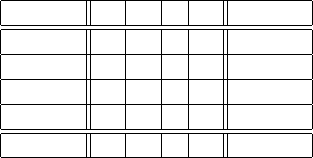Vidakovic B. Statistics for Bioengineering Sciences: With Matlab and WinBugs Support
Подождите немного. Документ загружается.

530 13 Goodness-of-Fit Tests
Phillips, D. P. (1972). Deathday and birthday: an unexpected connection. In: Tanur, J. M. ed.
Statistics: a guide to the unknown. Holden-Day, San Francisco, 52–65.
Risebrough, R. W. (1972). Effects of environmental pollutants upon animals other than man.
Proc. Sixth Berkeley Symp. on Math. Statist. and Prob., vol. 6, 443–453.
Smirnov, N. (1939). On the estimation of the discrepancy between empirical curves of distri-
bution for two independent samples. Bull. Math. Univ. Moscou, 2, 3–14.
Stansfield, W. D. and Carlton, M. A. (2007). Human sex ratios and sex distribution in sib-
ships of size 2. Hum. Biol., 79, 255–260.
Struhsaker, T. T. (1965). Behavior of the vervet monkey (Cercopithecus aethiops). Ph.D. dis-
sertation, University of California-Berkeley.
von Bortkiewicz, L. (1898). Das Gesetz der kleinen Zahlen. Teubner, Leipzig.
Yates, F. (1934). Contingency table involving small numbers and the
χ
2
test. J. R. Stat. Soc.,
1 (suppl.), 2, 217–235.

Chapter 14
Models for Tables
It seems to me that everything that happens to us is a disconcerting mix of choice and
contingency.
– Penelope Lively
WHAT IS COVERED IN THIS CHAPTER
• Contingency Tables and Testing for Independence in Categorical
Data
• Measuring Association in Contingency Tables
• Three-dimensional Tables
• Tables with Fixed Marginals: Fisher’s Exact Test
• Combining Contingency Tables: Mantel–Haenszel Theory
• Paired Tables: McNemar Test
• Risk Differences, Risk Ratios, and Odds Ratios for Paired Experi-
ments
14.1 Introduction
The focus of this chapter is the analysis of tabulated data. Although the mea-
surements could be numerical, the tables summarize only the counts along the
levels of two or more crossed factors according to which the data are tabulated.
In this text, we go beyond the traditional coverage and discuss topics such as
© Springer Science+Business Media, LLC 2011
B. Vidakovic, Statistics for Bioengineering Sciences: With MATLAB and WinBUGS Support, 531
Springer Texts in Statistics, DOI 10.1007/978-1-4614-0394-4_14,

532 14 Models for Tables
three-dimensional tables, multiple tables (Mantel–Haenszel theory), paired
tables (McNemar test), and risk theory (risk differences, relative risk, and
odds ratios) for paired tables. The risk theory for ordinary (unpaired) tables
was already discussed in Chap. 10 in the context of comparing two population
proportions.
The dominant statistical procedure in this chapter is testing for the inde-
pendence of two cross-tabulated factors. In cases where the marginal counts
are fixed before the sampling, the test for independence becomes the test for
homogeneity of one factor across the levels of the other factor. Although the
concepts of homogeneity and independence are different, the mechanics of the
two tests is the same. Thus, it is important to know how an experiment was
conducted and whether the table marginal counts were fixed in advance.
The paired tables, like the paired t-test or block designs, are preferred to
ordinary (or parallel) tables whenever pairing is feasible. In paired tables, we
would usually be interested in testing the agreement of proportions.
14.2 Contingency Tables: Testing for Independence
To formulate a test for the independence of two crossed factors, we need to
recall the definition of independence of two events and two random variables.
Two events R and C are independent if the probability of their intersection is
equal to the product of their individual probabilities,
P(R ∩C) =P(R) ·P (C).
For random variables independence is defined using the independence of
events. For example, two random variables X and Y are independent if the
events
{X ∈ I
x
} and {Y ∈ I
y
}, where I
x
and I
y
are arbitrary intervals, are inde-
pendent.
To motivate inference for tabulated data we also need a brief review of
two-dimensional discrete random variables, discussed in Chap. 4. A two-
dimensional discrete random variable (X ,Y ), where X
∈ {x
1
,... , x
r
} and Y ∈
{
y
1
,... , y
c
}, is fully specified by its probability distribution, which is given in
the form of a table:
y
1
y
2
··· y
c
Marginal
x
1
p
11
p
12
p
1c
p
1·
x
2
p
21
p
22
p
2c
p
2·
x
r
p
r1
p
r2
p
rc
p
r·
Marginal p
·1
p
·2
p
·c
1
The two components (marginal variables) X and Y in (X ,Y ) are independent
if all cell probabilities are equal to the product of the associated marginal

14.2 Contingency Tables: Testing for Independence 533
probabilities, that is, if p
i j
= P(X = x
i
,Y = y
j
) = P(X = x
i
)P(Y = y
j
) = p
i·
× p
·j
for each i, j. If there exists a cell (i, j) for which p
i j
6= p
i·
×p
·j
, then X and Y are
dependent. The marginal distributions for components X and Y are obtained
by taking the sums of probabilities in the table, row-wise and column-wise,
respectively:
X
x
1
x
2
... x
r
p p
1·
p
2·
... p
r·
and
Y
y
1
y
2
... y
c
p p
·1
p
·2
... p
·c
.
Example 14.1. If (X ,Y ) is defined by
X \ Y 10 20 30 40
−1 0.1 0.2 0 0.05
0 0.2 0 0.05 0.1
1 0.1 0.1 0.05 0.05
then the marginals are
X
−1 0 1
p 0.35 0.35 0.3
and
Y
10 20 30 40
p 0.4 0.3 0.1 0.2
, and X and
Y are dependent since we found a cell, for example, (2, 1), such that 0.2 =
P(X
=0,Y =10) 6= P(X =0) ·P(Y =10) = 0.35 ·0.4 =0.14. As we indicated, it is
sufficient for one cell to violate the condition p
i j
= p
i·
× p
·j
in order for X and
Y to be dependent.
Instead of random variables and cell probabilities, we will consider an em-
pirical counterpart, a table of observed frequencies. The table is defined by
the levels of two factors R and C. The levels are not necessarily numerical
but could be, and most often are, categorical, ordinal, or interval. For example,
when assessing the possible dependence between gender (factor R) and per-
sonal income (factor C), the levels for R are categorical {male, female}, and for
the C interval, say,
{[0,30K), [30K,60K), [60K,100K), ≥ 100K}. In the table
below, factor R has r levels coded as 1,..., r and factor C has c levels coded as
1,... , c. A cell (i, j) is an intersection of the ith row and the jth column and
contains n
i j
observations. The sum of the ith row is denoted by n
i·
while the
sum of the jth column is denoted by n
·j
.
1 2 ··· c Total
1 n
11
n
12
n
1c
n
1·
2 n
21
n
22
n
2c
n
2·
r n
r1
n
r2
n
rc
n
r·
Total n
·1
n
·2
n
·c
n
··
Denote the total number of observations n
··
=
P
r
i
=1
n
i·
=
P
c
j
=1
n
·j
simply by n.
The empirical probability of the cell (i, j) is
n
i j
n
, and the empirical marginal
probabilities of levels i and j are
n
i·
n
and
n
·j
n
, respectively.
When factors R and C are independent, the frequency in the cell (i, j) is
expected to be n
· p
i·
· p
·j
. This can be estimated by empirical frequencies

534 14 Models for Tables
e
i j
= n ×
n
i·
n
×
n
·j
n
,
that is, as the product of the total number of observations n and the corre-
sponding empirical marginal probabilities. After simplification, the empirical
frequency in the cell (i, j) for independent factors A and B is
e
i j
=
n
i·
×n
·j
n
.
By construction, the table containing “independence” frequencies e
i j
would
have the same row and column totals as the table containing observed frequen-
cies n
i j
, that is,
1 2 ··· c Total
1 e
11
e
12
e
1c
n
1·
2 e
21
e
22
e
2c
n
2·
r e
r1
e
r2
e
rc
n
r·
Total n
·1
n
·2
n
·c
n
··
To measure the deviation from independence of the factors, we compare
n
i j
and e
i j
over all cells. There are several measures for discrepancy between
observed and expected frequencies, the two most important being Pearson’s
χ
2
,
χ
2
=
r
X
i=1
c
X
j= 1
(n
i j
−e
i j
)
2
e
i j
,
(14.1)
and the likelihood ratio statistic G
2
,
G
2
=2
r
X
i=1
c
X
j=1
n
i j
log
µ
n
i j
e
i j
¶
.
Both statistics
χ
2
and G
2
are approximately distributed as chi-square with
(r
−1)×(c−1) degrees of freedom and their large values are critical for H
0
. The
approximation is good when cell frequencies are not small. Informal require-
ments are that no empty cells should be present and that observed counts
should not be less than 5 for at least 80% of the cells. We focus on
χ
2
since the
inference using statistic G
2
is similar.

14.2 Contingency Tables: Testing for Independence 535
Thus, for testing H
0
: Factors R and C are independent, versus H
1
: Factors
R and C are dependent, the test statistic is
χ
2
given in (14.1) and the test is
summarized as
Null Alternative α-level rejection region p-value (MATLAB)
H
0
: R,C ind. H
1
: R,C dep. [χ
2
d f ,1
−α
,∞) 1-chi2cdf(chi2, df)
where d f =(r −1) ·(c −1).
When some cells have expected frequencies
< 5, the Yates correction for
continuity is recommended, and statistic
χ
2
gets the form
χ
2
=
r
X
i=1
c
X
j=1
(|n
i j
−e
i j
|−0.5)
2
e
i j
.
We denote by p
i j
the population counterpart to
ˆ
p
i j
=
n
i j
n
and by p
i·
and p
·j
the population counterparts of
ˆ
p
i·
= n
i·
/n and
ˆ
p
·j
= n
·j
/n. In terms of p, the
independence hypothesis takes the form
H
0
: p
i j
= p
i·
× p
·j
for all i, j versus H
1
: p
i j
6= p
i·
× p
·j
for at least one i, j.
The following MATLAB program,
tablerxc.m, calculates expected fre-
quencies, the value of the
χ
2
statistic, and the associated p-value.
function [chi2, pvalue, exp, assoc] = tablerxc(obs)
% Contingency Table r x c for testing the probabilities
%
% Input:
% obs - r x c matrix of observations.
%
% Output:
% chi2 - statistic (approx distributed as chi-square
% with (r-1)(c-1) degrees of freedom)
% pvalue - p - value
% exp - matrix of expected frequencies
% asoc - structure containing association measures: phi,
% C, and Cramer’s V
% Example of use:
% [chi2,pvalue,exp,assoc]=tablerxc([6 14 17 9; 30 32 17 3])
%-------------------------------------------------------
[r c]=size(obs); %size of matrix
n = sum(sum(obs)); %total s. size
columns = sum(obs); %col sums 1 x c
rows = sum(obs’)’; %row sums r x 1
exp = rows
*
columns ./ n; %[r x c] matrix
chi2 = sum(sum((exp - obs).^2./exp ));
df=(r-1)
*
(c-1);

536 14 Models for Tables
pvalue = 1- chi2cdf(chi2, df);
% measures of association
if (df == 1)
assoc.phi = sqrt(chi2/n);
end
assoc.C = sqrt(chi2/(n + chi2));
assoc.V = sqrt(chi2/(n
*
(min(r,c)-1)));
Example 14.2. PAS and Streptomycin Cures for Pulmonary Tuberculo-
sis. Data released by the British Medical Research Council in 1950 (ana-
lyzed also in Armitage and Berry, 1994) concern the efficiency of para-amino-
salicylic acid (PAS), streptomycin, and their combination in the treatment
of pulmonary tuberculosis. Outcomes of sputum culture test performed on
patients after the treatment are categorized as “Positive Smear,” “Negative
Smear & Positive Culture,” and “Negative Smear & Negative Culture.”
The table below summarizes the findings on 273 treated patients with a
TB diagnosis.
Smear (+) Smear (–) Smear (–) Total
Culture (+) Culture (–)
PAS 56 30 13 99
Streptomycin 46 18 20 84
PAS & Streptomycin 37 18 35 90
Total 139 66 68 273
There are two factors here: cure and sputum results. We will test the hy-
pothesis of their independence at the level
α =0.05.
D =[ ...
56 30 13 ; %99
46 18 20 ; %84
37 18 35 ]; %90
% 139 66 68 273
[chi2,pvalue,exp] = tablerxc(D)
% chi2 = 17.6284
% pvalue = 0.0015
% exp =
% 50.4066 23.9341 24.6593
% 42.7692 20.3077 20.9231
% 45.8242 21.7582 22.4176
The p-value is 0.0015, which is significant. For α = 0.05, the rejection re-
gion of the test comprise values larger than
chi2inv(1-0.05, (3-1)
*
(3-1)),
which is the interval [9.4877,
∞). Since 17.6284 > 9.4877, the hypothesis of
independence is rejected.

14.2 Contingency Tables: Testing for Independence 537
14.2.1 Measuring Association in Contingency Tables
In a contingency table, statistic χ
2
tests the hypothesis of independence and
in some sense measures the association between the two factors. However, as
a measure,
χ
2
is not normalized and depends on the sample size, while its
distribution depends on the number of rows and columns. There are several
measures that are calibrated to the interval [0,1] and measure the strength
of association in a way similar to R
2
in a regression context. We discuss three
measures of association: the
φ-coefficient, the contingency coefficient C, and
Cramer’s V coefficient.
φ-Coefficient. If a 2 ×2 contingency table classifying n elements pro-
duces statistic
χ
2
, then the φ-coefficient is defined as
φ =
s
χ
2
n
.
Contingency Coefficient C. If an r
×c contingency table classifying
n elements produces statistic
χ
2
, then the contingency coefficient C is
defined as
C
=
s
χ
2
χ
2
+n
.
Cramer’s V Coefficient. If an r
× c contingency table classifying n
elements produces statistic
χ
2
, then Cramer’s V coefficient is defined as
V
=
s
χ
2
n(k −1)
,
where k is the smaller of r and c, k
= min{r, c}. If the number of levels
for any factor is 2, then Cramer’s V becomes the
φ-coefficient.
Example 14.3. Thromboembolism and Contraceptive Use. A data set,
considered in more detail by Worchester (1971), contains a cross-classification
of 174 subjects with respect to the presence of thromboembolism and contra-
ceptive use as a risk factor.

538 14 Models for Tables
Contraceptive use No contraceptive use Total
Thromboembolism 26 32 58
Control 10 106 116
Total 36 138 174
Statistic χ
2
is 30.8913 with p-value = 2.7289·10
−8
, and the hypothesis of in-
dependence of thromboembolism and contraceptive usage is strongly rejected.
For this table:
φ =
s
χ
2
n
=
s
30.8913
174
=0.4214,
C
=
s
χ
2
χ
2
+n
=
s
30.8913
30.8913 +174
=0.3883.
For 2
×2 tables φ and Cramer’s V coincide. The fourth component in the output
of
tablerxc.m is a data structure with measures of association.
[chi2, pvalue, exp, stat]=tablerxc([26,32; 10,106])
%chi2 = 30.8913
%pvalue = 2.7289e-008
%
%exp =
% 12 46
% 24 92
%
%stat =
% phi: 0.4214
% C: 0.3883
% V: 0.4214
Example 14.4. Galton and ALW Features in Fingerprints. In his influen-
tial book Finger Prints, Sir Francis Galton details the description and distri-
butions of arch-loop-whorl (ALW) features of human fingerprints (Fig. 14.1).
Some of his findings from 1892 are still in use today.
Tables 14.1a,b are from Galton (1892) and tabulate ALW features on fore-
fingers in pairs of school children.
In Table 14.1a subjects A and B are paired at random from a large pop-
ulation of subjects. In Table 14.1b, subjects A and B are two brothers with a
random assignment of order (A, B).
Galton was interested in knowing if there was any influence of fraternity
on the dependence of ALW features. Using a
χ
2
-test, test for the dependence
in both tables.
H
0
: Individuals A and B are independent if characterized by their finger-
print features.

14.2 Contingency Tables: Testing for Independence 539
(a) (b) (c)
Fig. 14.1 (a) Arch, (b) loop, and (c) whorl features in a fingerprint.
Table 14.1 (a) Table with random pairing of children. (b) Table with fraternal pairing.
A
Arch Loop Whorl
B
Arch 5 12 8
Loop 8 18 8
Whorl 9 20 13
A
Arch Loop Whorl
B
Arch 5 12 2
Loop 4 42 15
Whorl 1 14 10
(a) (b)
MATLAB output:
[chisq, p, expected,assoc]=tablerxc([5 12 8; 8 18 8; 9 20 13])
%(a) random pairing
%chisq = 0.6948
% p = 0.9520
% expected =
% 5.4455 12.3762 7.1782
% 7.4059 16.8317 9.7624
% 9.1485 20.7921 12.0594
% assoc =
% C: 0.0827
% V: 0.0586
[chisq, p, expected,assoc]=tablerxc([5 12 2; 4 42 15; 1 14 10])
%(b) fraternal pairing
% chisq = 11.1699
% p = 0.0247
% expected =
% 1.8095 12.3048 4.8857
% 5.8095 39.5048 15.6857
% 2.3810 16.1905 6.4286
% assoc =
% C: 0.3101
% V: 0.2306
It is evident that for random pairing, the hypothesis of independence H
0
is
not rejected (p-value 0.9520), while in the case of fraternal pairing the finger-
print features are significantly dependent (p-value 0.0247).
Power Analysis. Power analysis for contingency tables involves evalua-
tion of a noncentral
χ
2
in which the noncentrality parameter λ depends on an
appropriate effect size.
